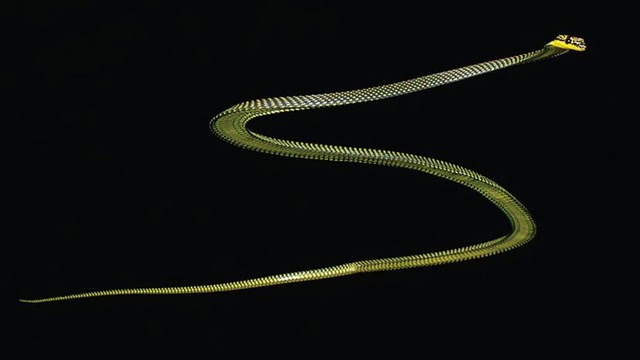Quck answer
Some species of snakes have the ability to glide through the air, despite not having wings. These “flying” snakes, found in Southeast Asia, flatten their bodies and use their scales to generate lift as they launch themselves from trees. By undulating their bodies, they can steer themselves to land on another tree or the ground. This adaptation allows them to avoid predators and reach new areas for food and mating. While they may not actually fly in the traditional sense, the gliding ability of these snakes is still impressive and unique among reptiles.
Wild animals

While birds, bats, insects, and pterosaurs are the only groups of organisms that have evolved the ability to fly, the genus Chrysopelea, or “flying” snakes, have adapted to glide over long horizontal distances without wings. These five snake species, which inhabit the rainforests of southern and southeastern Asia, are consummate tree-dwellers and are unable to travel upwards through the air due to their inability to produce thrust. However, they are capable of gliding from treetop to treetop more easily, a trait that is also common in other gliding animals in the region.
The Mechanics of Gliding
When a flying snake launches itself off a tree or elevated surface, its ribs splay outwards, flattening the animal from the neck to the nether regions, which helps create lift and makes their bodies more aerodynamic. While the reason for their gliding is still unknown, herpetologist Jake Socha has observed the snakes using it for escape from predators and effective locomotion between trees or to the ground.
Flying Snakes Master Skillful Slithering
Flying snakes are also known to slither while gliding, and it is unknown if this behavior helps the gliding process or is merely a behavioral relic.
The movement of flying snakes has been studied in a 2020 publication in the Nature Physics journal, written by Socha, Isaac J. Yeaton, Shane D. Ross, and Grant A. Baumgardner. The researchers observed the choreography of seven paradise tree snakes gliding in a controlled, indoor setting using high-speed cameras and motion-capture technology. They used this data to develop a 3D digital model of the reptiles. The simulations revealed that the snakes undulate both horizontally and vertically while gliding to maintain stability. Chrysopelea snakes are also capable of changing direction mid-glide and will twist their bodies into a “J-shaped” loop before takeoff. These snakes are part of the colubrid family, which includes corn snakes, garter snakes, and kingsnakes. They are diurnal and hunt birds, bats, lizards, and frogs during the day. Despite carrying venom, Chrysopelea snakes are not dangerous to humans, and none of the five known species are considered endangered.
FAQ
What are flying snakes?
Flying snakes, also known as gliding snakes, are a group of arboreal snakes that have the ability to glide through the air. They use their long, slender bodies and broad, flattened tails to generate lift and control their descent. Despite their name, flying snakes are not actually capable of powered flight like birds or bats. Instead, they rely on passive aerial locomotion to move from tree to tree.
Where do flying snakes live?
Flying snakes are found in Southeast Asia, specifically in the rainforests of Indonesia, Malaysia, Thailand, and the Philippines. They are arboreal, which means they live in trees, and can be found in both primary and secondary forests. Flying snakes are most commonly found in the canopy layer of the forest, where they have plenty of room to glide between trees.
How do flying snakes glide?
Flying snakes use a unique method of gliding called “concertina” gliding. They flatten their bodies from side to side, which creates a series of curves that act like wings. As they glide, they undulate their bodies in a wave-like motion, which allows them to control their direction and speed. The broad, flattened tail acts as a rudder, helping to steer the snake as it glides through the air. Flying snakes can glide for distances of up to 100 feet, and can even make mid-air turns.
Are flying snakes dangerous?
Although they may look intimidating, flying snakes are not considered to be dangerous to humans. They are non-venomous and rarely bite, preferring to use their gliding abilities to escape predators rather than confront them. However, like all wild animals, they should be respected and left alone in their natural habitats.
Why do flying snakes glide?
The exact reason why flying snakes evolved the ability to glide is not fully understood. Some scientists believe that it may have evolved as a way to escape predators, while others think it may be a way to move more efficiently through the forest canopy. Whatever the reason, the ability to glide has allowed flying snakes to thrive in their rainforest habitats, where they can move quickly and easily through the trees.





Leave a Reply